Llano in the Wild: Toshiba's Satellite L775D-S7206
by Dustin Sklavos on August 12, 2011 12:45 AM ESTSeventeen Inches of Mediocrity
The more notebooks I review, the more I find that the bog standard resolutions available for many of these form factors just aren't enough. 1366x768 in a 15.6" notebook borders on offensive, but 1600x900 at 17.3" really isn't a walk in the park either. The overall resolution is an improvement from the 1440x900 that old 17" notebooks used to run at, but dot pitch is still high. It seems like if you want a good screen, you need to find a notebook that supports 1080p.
Toshiba's Satellite L775D-S7206 sports a middling 17.3", LED-backlit 1600x900 screen that's serviceable but as you'll see, utterly unexciting. This is to be expected given the price tag and resulting market the notebook is aimed at.
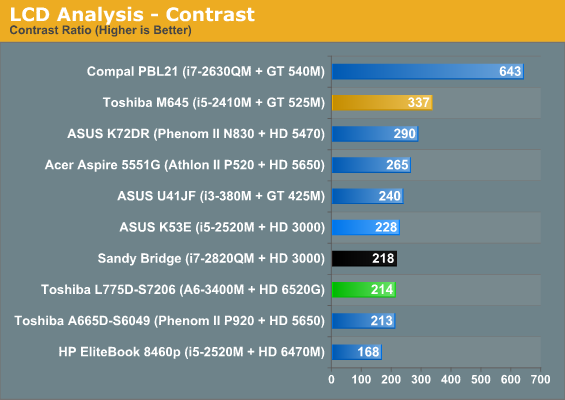
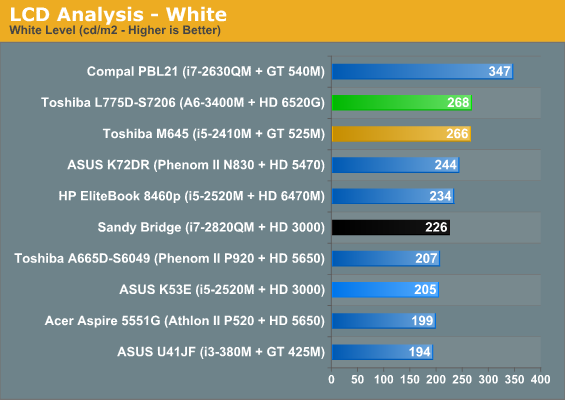

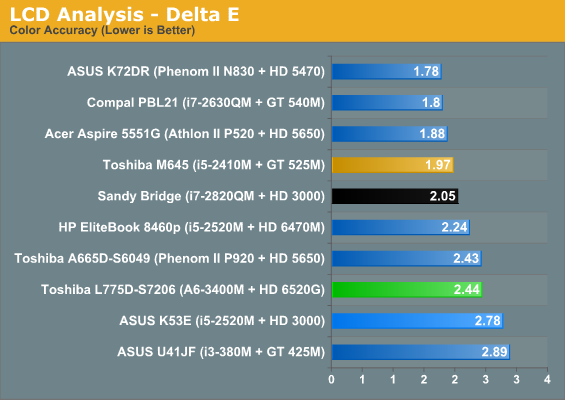
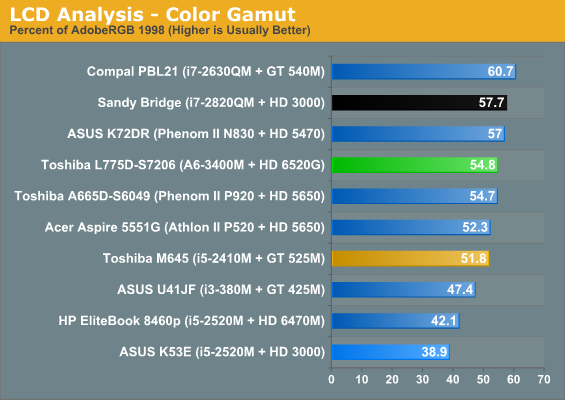
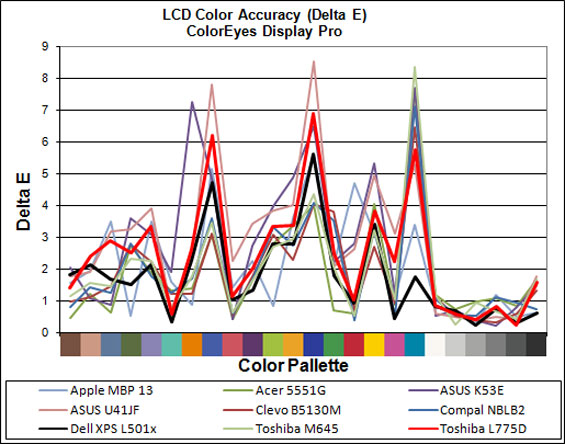
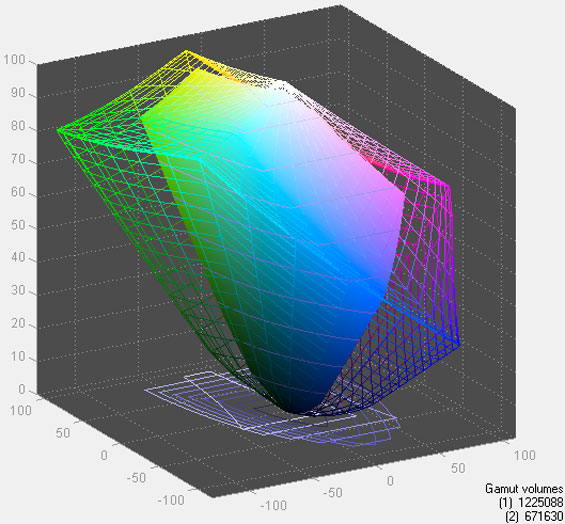
Poor black levels keep the Satellite's Samsung panel from achieving a decent contrast ratio, and while the color gamut is alright, accuracy is in the toilet. Overall the screen is bright enough, but we're most definitely in budget laptop territory.
Viewing angles don't fare much better. This is a TN panel through and through and while notebooks like the substantially more expensive Alienware M17x R3 prove TN panels don't have to suck, it's still frustrating to see technology this mediocre continuing to run wild.















74 Comments
View All Comments
Slaimus - Friday, August 12, 2011 - link
Can you add a gaming battery life test? I think there is an area where this laptop should have a trump card compared to one with a dedicated graphics card.Beenthere - Friday, August 12, 2011 - link
I think it's clear that Llano is a good laptop APU and that AMD has created a specific market segment as a result. Llano is OK for an inexpensive desktop systems but low end Bulldozer CPUs and discrete graphics would be far better. Trinity will follow Llano so AMD has many good products in the pipeline, which is great for consumers.DudleyUC - Friday, August 12, 2011 - link
People (anandtech staff) are putting too much value in CPU performance. Yes, the SB i7s kick the bejesus out of any Llano in CPU tasks. Truth is, the vast majority of users don't make use of that kind of performance the vast majority of the time (or ever). Good enough performance for less money is a much better choice than more performance than you need for considerably more money. I'll take a Honda Civic for 20k over a McClaren for 1M, because I'm never going to drive at 240mph either way.joe_dude - Friday, August 12, 2011 - link
LOL... Intel: faster spell check, can't play games. You winner!BSMonitor - Friday, August 12, 2011 - link
You are absolutely wrong. MOST people don't play FPS on their $600 laptop, nor would they EVER want to. That kind of gaming is so niche that it really doesn't register in the grand scheme.People want all their applications to run quickly and smoothly. They want their iTunes to convert songs as fast as possible. And they want to do these things simultaneously.
CPU performance is EVERYTHING. If you want GPU performance, you don't want an IGP or APU, you get a dedicated chip.
bji - Friday, August 12, 2011 - link
While both yours and the O.P.s points are gross generalizations, I tend to agree with the O.P. more. Everybody knows that CPU speed reached a point of diminishing returns years ago, with the newest, fastest processors hardly distinguishable from budget processors in most tasks. And although I don't know this for sure, I espect that most people who buy laptops, let alone people buying budget laptops, don't do very CPU-intensive tasks with them very often. These two points alone make CPU speed highly insignificant for most users.GPU performance is definitely noticeable though; if you do any gaming at all, you are going to easily be able to tell the difference between GPU performance at every level.
I think that for most people, having a laptop that is "good enough" in every category is a vast improvement over a laptop that is overkill in one department (CPU) and lacking in another (GPU).
jabber - Saturday, August 13, 2011 - link
As I've said before I could put a Athlon II 3Ghz dual core in a PC and i7 in another and my customers wouldnt be able to tell the difference for what they do. They just dont care. Ultimate CPU performance for many is a non issue. As long as they dont keep seeing the old eggtimer like they did with their old single core 3Ghz P4s they are happy.What does bug them is slow HDD access. If I put a 64GB SSD in the Athlon box and a 1TB 7200rpm in the i7 box they will take away the Athlon one everytime even if I sold them for the same price.
joe_dude - Friday, August 12, 2011 - link
For most regular users, accessing e-mail, Youtube and Facebook is all they really need or want. If that wasn't the case, no one would buy MBAs or tablets.The A6 and A8 with quad-core is more than smooth enough. AMD demoed it earlier in the year to show how good multitasking is compared to Core IX.
Raw CPU power is for bragging rights and server applications.
DudleyUC - Friday, August 12, 2011 - link
Oh but I'm not absolutely wrong. Not wrong at all in fact, although I did overgeneralize as bji pointed out. People DO play games on their laptops. They're called college kids (between classes, during classes, always with the world of warcraft/sims/whatever they're hooked on). And like I said, i7 vs. APU is no contest CPU-wise, but both processors run applications quickly and smoothly; it's the HDD that slows you down the most. I'd also wager a bet that more and more websites and programs will start to utilize hardware acceleration (i.e. gpu) more frequently and effectively.If you want your iTunes songs converted faster and never want to run anything GPU intensive, go ahead and spend the extra money on an intel cpu.
JarredWalton - Friday, August 12, 2011 - link
Where you're completely missing the point is that there's no need to give up CPU performance just to get a better iGPU. So this Toshiba laptop can be had for around $600 ($700 MSRP). Who would pay $700 for an A6 laptop when you can grab an i5-2410M with Optimus GT 540M starting at under $700:http://www.tigerdirect.com/applications/searchtool...
But it's not quite so simple, is it? Toshiba gives you a Blu-ray combo drive for $600, and that's currently about a $90 upgrade if you do it on your own. Which is of course part of the reason we feel the Toshiba L775D is priced appropriately, at least when you can get the S7226 model for $600. Would you really want to pay $700 for an A6 (or even A8) when you could get Sandy Bridge with Optimus graphics (e.g. faster in applications and applications, with better battery life provided you're not trying to play a game untethered) for the same price? If so, I'd question your judgement, just like I would question the judgement of an average joe going out and buying a $100,000 car he can't afford.
But that's why we have the Gateway NV55S05u selling for $580 after a $120 instant rebate, and HP Pavilion dv6-6140us for $600 after $100 instant rebate and $50 mail-in rebate. Both of those come with A8-3500M, and the HP gets you Blu-ray combo thrown into the mix. To those that think I/we are biased in favor of Intel, we're not. Llano is a good product for the target market, provided it's priced appropriately. Manufacturers know this as well, so they're dropping prices on Llano laptops and cutting margins, because otherwise the laptops won't sell.
Your analogy about vehicles, incidentally, is absurd. Sure, a Honda Civic for $20K is definitely more practical than a McLaren F1 for $1M, but that's stupid -- nobody is talking about a McLaren F1 here. If Llano is a Civic, the McLaren F1 would be a desktop GTX 580 SLI with hex-core i7-980X all stuffed into a 13" chassis with an amazing display, but a keyboard that's a bit difficult to use (which obviously doesn't exist because nobody has even tried to make a $30000 laptop). An Alienware M18x SLI notebook is "only" six times the cost of a Llano laptop, so that would be something like a tricked out Landrover or Hummer. And if we're looking at stuff like mainstream $1000 laptops--Dell XPS 15 for instance--we'd be talking about sedans and minivans. Those certainly have a place in the world.
What if you could find a vehicle that gets better gas mileage than the Civic, has a top speed and acceleration that are twice that of the Civic, and better handling as well, and it's available with essentially the exact same features, size, etc. as the Civic at a very small price premium. Like the McLaren F1 equivalent laptop, such a car doesn't actually exist (that I know of), but if you could have that for $22K, wouldn't you pay the extra $2k (10%) to get improved gas mileage and performance? Okay, you might want a better keyboard than the Acer linked above, so what about if it costs $24K, or $26K?
And that is the real question you have to answer. It's also why making blanket statements about how Llano is awesome, or Llano sucks, or Intel laptops are too expensive, or Intel IGP sucks, etc. are pointless. Depending on the specific needs of an individual, one or more of those statements might be true, but we are all individuals. Last time I checked, we aren't all clones with identical needs/wants/desires.